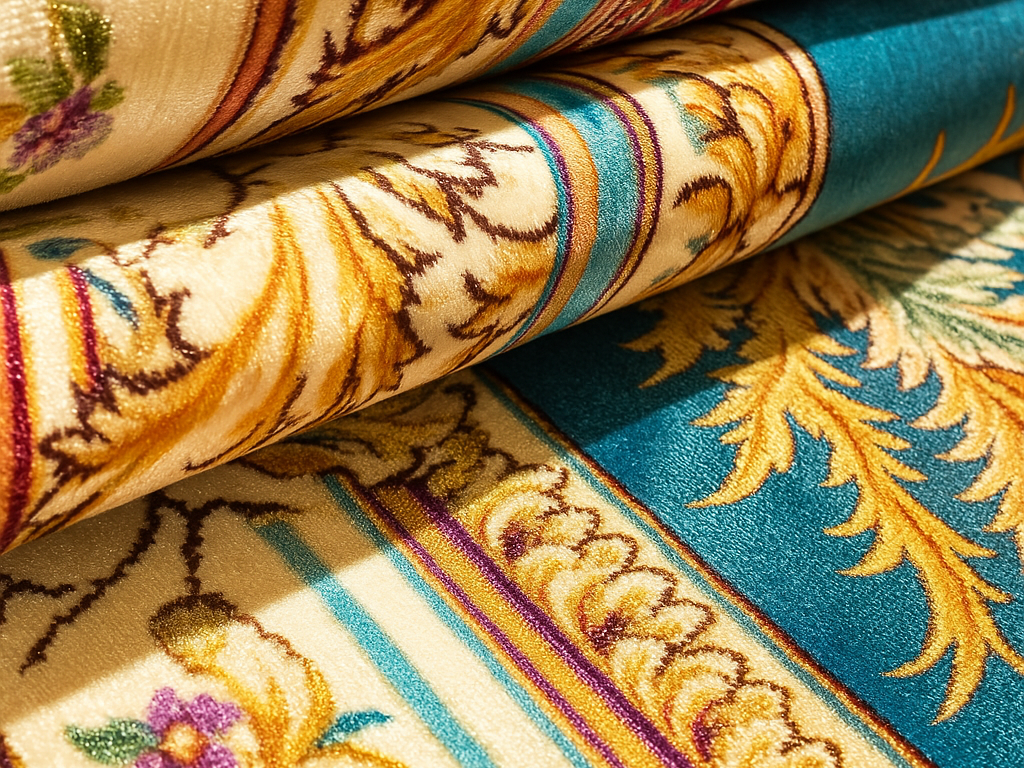インテリアデザインにおいて、ラグは単なる床材ではありません。部屋のアクセントになり、暖かみを加え、インテリアを格上げしてくれます。しかし、ラグの種類や素材、スタイルが多すぎて、どれがいいのか迷ってしまいます。
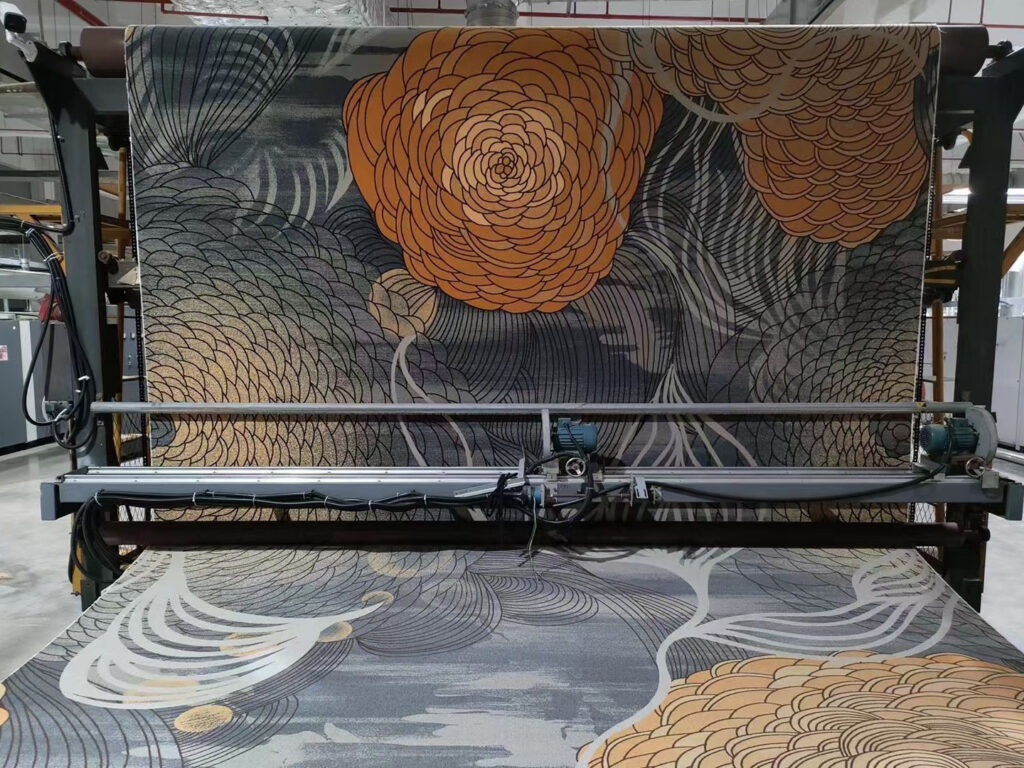
この包括的なラグ購入ガイドでは、必要な情報をすべて網羅しています:
- 最高のラグ素材(ウール、ジュート、シルク、合成繊維など)
- ラグの製法(手織り、タフテッド、機械織り、平織り)
- 正しいラグスタイルの選択(トラディショナル、モダン、ボヘミアン、ヴィンテージ)
- ラグの配置のヒント(サイズ、重ね方、部屋ごとのアドバイス)
豪華なリビングルーム用ラグ、丈夫なキッチン用ランナー、スタイリッシュなベッドルーム用アクセントなど、このガイドを参考に、あなたのスペースに最適なラグをお選びください。
床を変える準備はできていますか?さあ、飛び込もう!
1. 素材別ラグ
ラグの素材は、見た目や質感だけでなく、耐久性やコスト、メンテナンス性も左右します。ここでは、最も一般的なラグの素材について説明します。
1.1 ウールラグ
ウールラグは長い間、耐久性、快適さ、そして時代を超越した美的魅力の卓越したブレンドで賞賛されてきました。最も伝統的で長持ちするラグ素材のひとつであるウールには、さまざまなメリットがあり、さまざまなインテリアシーンで好まれています。
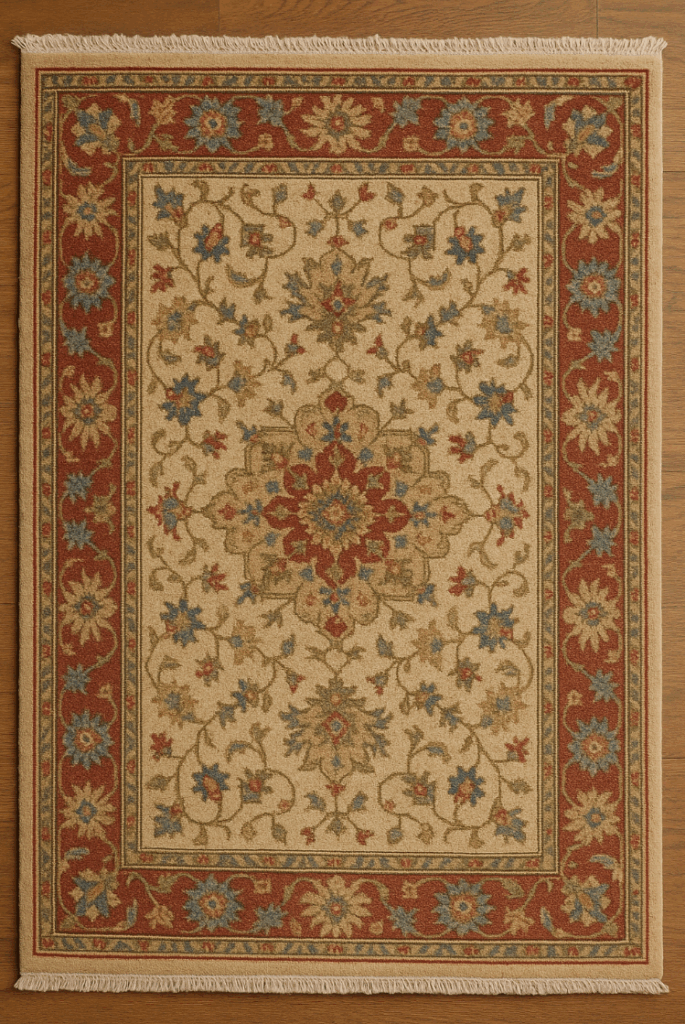
ウールラグの主な利点
- 耐久性と寿命:ウール繊維はもともと弾力性があり、ラグは激しい足の動きにも耐えることができます。高品質のウールラグは何十年も使えます。
- 自然な防汚性:ウール繊維に施されたラノリンコーティングは防汚効果があり、食べこぼしを簡単に拭き取れ、長期間ラグの美しさを保つことができます。
- 快適性と断熱性:ウールラグは足元がふかふかで、保温性に優れているため、寒い季節に部屋を暖かく保ち、全体的な快適性を高めます。
- 吸音:ウールラグの緻密な繊維は音を吸収し、騒音レベルを下げ、より静かで穏やかな環境を作り出します。
ラグに使われるウールの種類
ウールの種類によって、ラグの質感、外観、耐久性が異なります:
- メリノウール:その柔らかさと繊細な繊維で知られるメリノウールは、快適さを優先する高級ラグによく使われています。
- シェットランド・ウール:この粗めのウールは耐久性に優れ、素朴なデザインや人通りの多い場所に適しています。
- ペルシャウール:耐久性と豊かな織りの伝統で有名なペルシャウールは、一般的に高品質の手織りラグに使われています。
メンテナンスとケア
ウールラグの美しさを保ち、長持ちさせるには適切なケアが不可欠です:
- 定期的な掃除機がけ:ウールラグの繊維に汚れが入り込むのを防ぐため、掃除機は毎週かけてください。ウールを保護するため、高さを調節できる掃除機を使用し、ビーターバーや回転ブラシは避けてください。
- スポット・クリーニング:シミがこぼれた場合は、清潔な乾いた布で速やかに拭き取ってください。こするとシミが繊維の奥に入り込んでしまうので、こすらないようにしましょう。
- プロフェッショナル・クリーニング:使用状況にもよりますが、ウールラグは1~3年ごとに専門業者にクリーニングを依頼することをお勧めします。
- 直射日光を避ける:長時間の直射日光は色あせの原因になります。定期的に窓を開けたり、ラグを回転させるなどして、日光が均一に当たるようにしてください。
1.2 コットンラグ
コットンラグは、快適さ、手頃な価格、スタイルのバランスを求める住宅所有者に人気のある選択肢です。天然コットン繊維で作られたラグは、足ざわりがソフトで、さまざまなデザインとカラーがあり、さまざまなインテリアにマッチします。
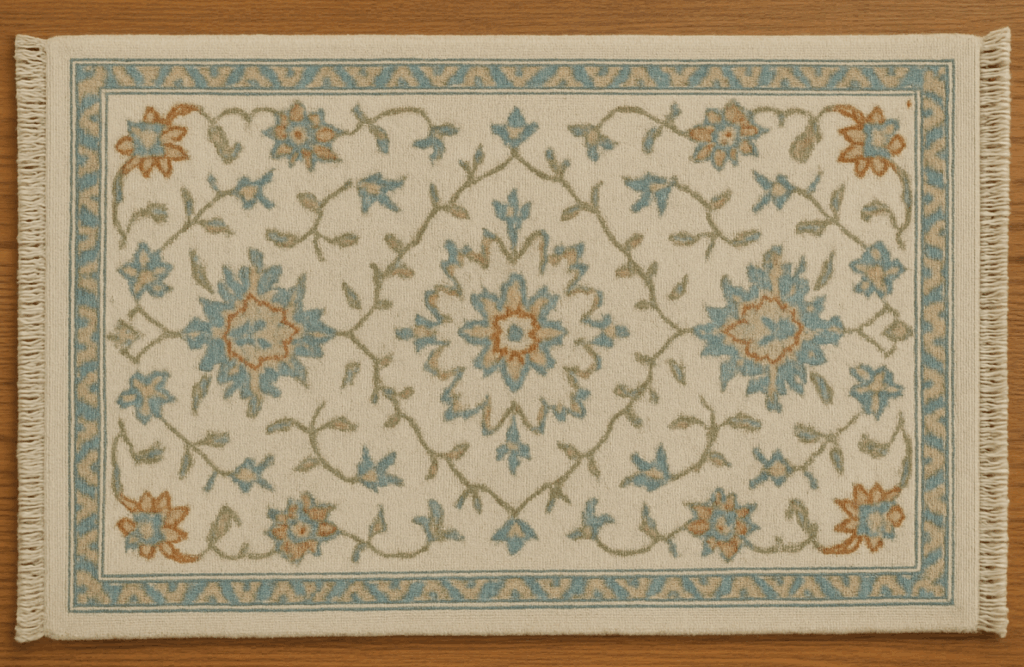
コットンラグの主な利点
- 柔らかさと快適さ:コットンラグは優しい肌触りで知られ、寝室やリビングルームなどに最適な、居心地の良い快適な表面を提供します。
- 簡単 メンテナンス:多くのコットンラグは洗濯機で洗えるので、お手入れが簡単で、お子様やペットのいるご家庭にも適しています。
- 手頃な価格:ウールやシルクのような素材のラグに比べ、コットンラグは一般的に予算が抑えられます。
- 環境にやさしい:天然繊維であるコットンは生分解性があり、再生可能であるため、環境意識の高い消費者にアピールできる。
- デザインの多様性:さまざまな柄、色、織りのコットンラグは、モダンからトラディショナルまで、幅広いインテリアスタイルを引き立てます。
メンテナンスとケア
適切なお手入れをすることで、コットンラグの寿命を延ばすことができます:
- 定期クリーニング:定期的に掃除機をかけ、汚れやゴミを取り除きます。小さなラグの場合は、中性洗剤を使って洗濯機で洗うのが適切な場合が多いですが、必ずメーカーの指示を確認してください。
- スポット・クリーニング:シミを防ぐため、こぼれた場合はすぐに湿らせた布で拭いてください。
- 直射日光を避ける:日光に長時間さらされると色あせの原因になります。ラグを直射日光の当たらない場所に置くか、ウィンドウトリートメントを使用してこの影響を軽減してください。
1.3 ジュートと天然繊維のラグ
天然繊維のラグ、特にジュート、サイザル麻、シーグラス製のラグは、環境にやさしく、オーガニックな美しさで人気を集めています。これらのラグは室内に自然のタッチをもたらし、さまざまなインテリアスタイルを引き立てるテクスチャーとトーンを提供します。
ジュートは長くて柔らかく、光沢のある植物性繊維で、紡いで粗く丈夫な糸にすることができる。主にインドとバングラデシュで栽培されるジュートは、その自然な色合いと高い換金性から、しばしば「黄金の繊維」と呼ばれる。
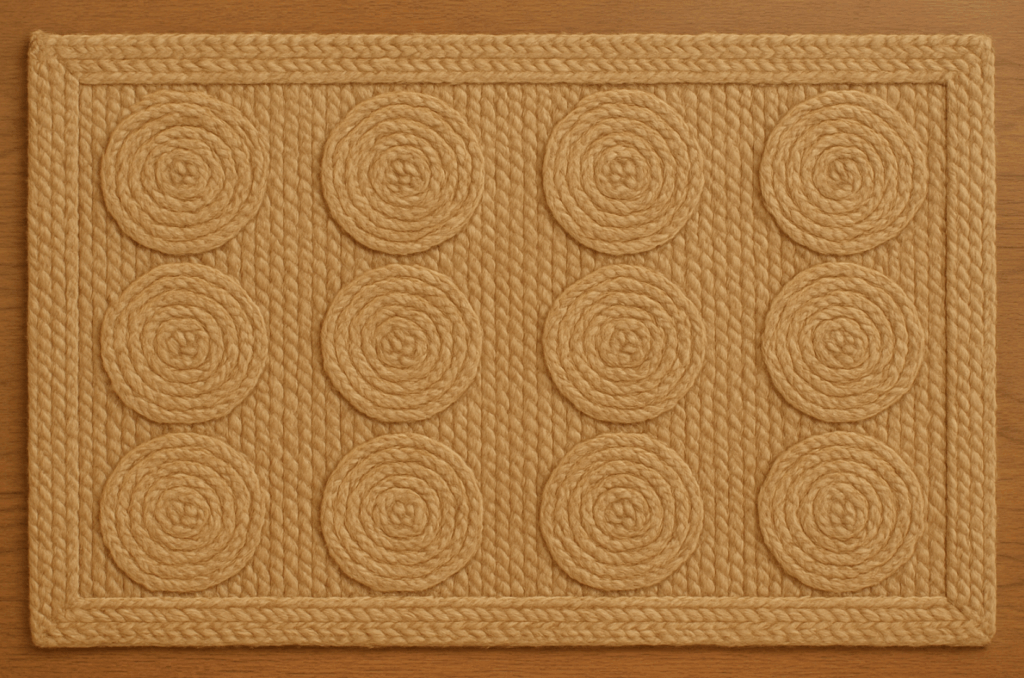
メリット
- 環境にやさしい:ジュートは生分解性があり、再生可能であるため、環境に配慮した素材です。
- 美的アピール:ナチュラルな黄金色のジュートは、インテリアに温かみと質感を加え、ミニマリズム、海岸、ボヘミアンなどのデザインにシームレスにフィットします。
- 手頃な価格:一般的にサイザル麻のような他の天然繊維よりも手ごろな価格のジュートは、自然な風合いを求める人たちにとって予算に優しい選択肢です。
1.4 シルクラグ
シルクラグ 豪華さと芸術性を象徴するラグで、輝く光沢、複雑なデザイン、比類のない柔らかさで有名です。蚕が生み出す繊細な繊維から作られるこれらのラグは、機能性と芸術性を融合させた傑作として知られています。
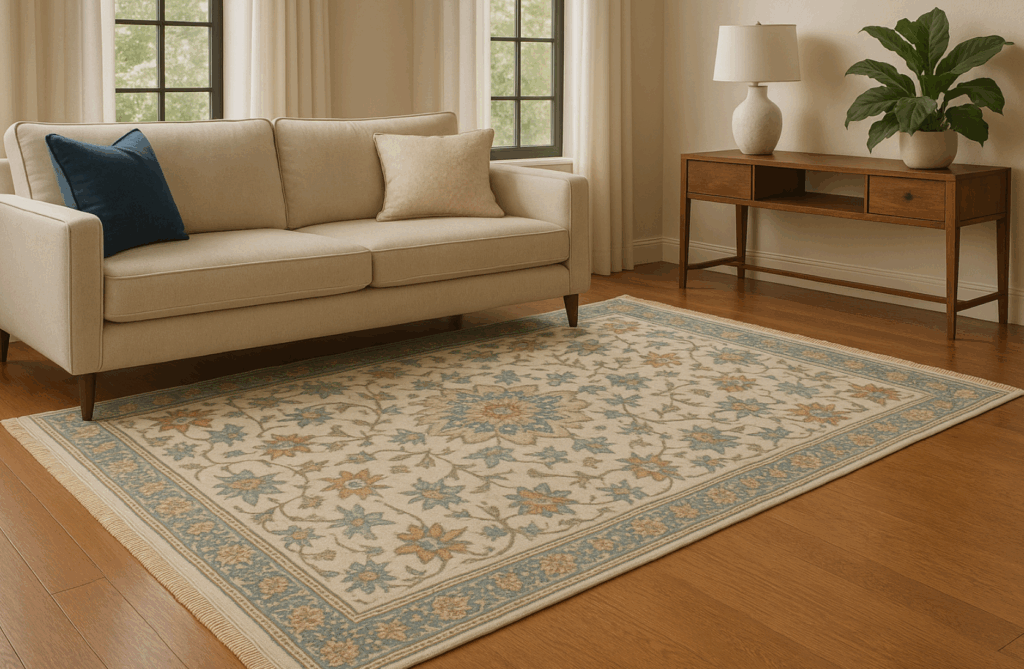
シルク・ラグの特徴
- 光沢のある外観:シルク繊維は光を反射する自然な光沢があり、見る角度によって輝きが変わります。
- 複雑なデザイン:絹糸は細いため、結び目の密度が高く、職人は細かい模様やモチーフを作ることができる。
- ソフトな質感:シルクのラグは足元が滑らかで高級感があり、どんな空間も快適にしてくれます。
- 色の鮮やかさ:シルクは染料を吸収しやすいため、豊かで鮮やかな色彩が得られ、インテリアの美的魅力を高めます。
ラグに使われるシルクの種類
- ピュア・シルク:蚕の繭から作られる正絹ラグは、最も贅沢で、最も高価なものです。
- シルク・ブレンド:シルクをウールやコットンのような他の繊維と組み合わせることで、シルクの望ましい性質を保ちながら耐久性を高めることができます。
- 人工シルク:ビスコースやバンブーシルクのような素材は、本物のシルクの見た目に似ていますが、耐久性や光沢には欠けるかもしれません。
メンテナンスとケア
シルクの絨毯は、その美しさを保つために細心の注意が必要です:
- 定期クリーニング:ビーターバーを使わず、やさしく掃除機をかけることで、ホコリを取り除き、繊維の損傷を防ぎます。
- 即時流出対応:シミがこぼれた場合は、清潔な乾いた布で速やかに拭き取ってください。こするとシミが広がったり、繊維を傷めることがあります。
- プロフェッショナル・クリーニング:シルクラグはデリケートなため、定期的に専門業者にクリーニングを依頼することをお勧めします。
- 直射日光を避ける:日光に長時間当てると色落ちすることがあります。シルクラグは直射日光の当たらない場所に置くか、ウィンドウトリートメントで保護してください。
プレースメントに関する推奨事項
シルクのラグはデリケートなので、人通りの少ない場所に最適です:
- フォーマル・リビング:エレガントで、会話のネタにもなる。
- ベッドルーム:足元の快適性と高級感を高める。
- 壁掛け:ラグの芸術性を発揮し、状態を保ちます。
1.5 合成ラグ(ナイロン、ポリプロピレン)
合成繊維の絨毯、特にその素材は次のようなものです。 ナイロン とポリプロピレン(オレフィンとしても知られている)は、その手頃な価格、耐久性、メンテナンスのしやすさから、ますます人気が高まっている。これらの素材は、特に人の出入りが多い場所や、子供やペットのいる家庭など、さまざまな家庭のニーズに実用的なソリューションを提供します。
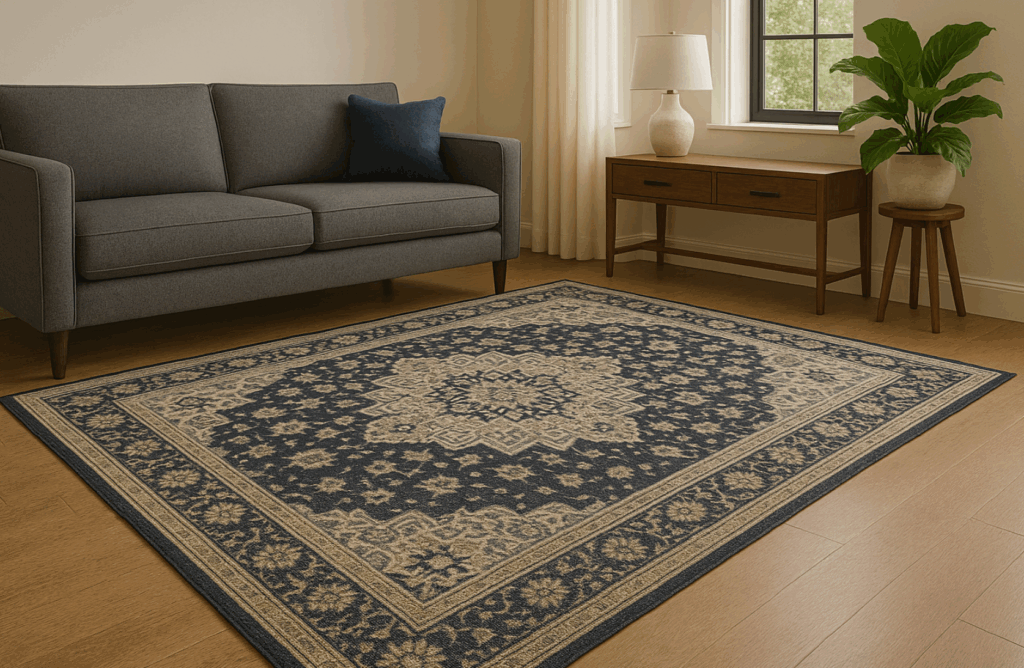
ナイロン ラグ
概要:ナイロンは強度、弾力性、多用途性で知られる合成繊維です。1940年代からカーペット業界では定番となっており、住宅用、商業用ともに広く使用されています。
メリット:
- 耐久性:ナイロン繊維は弾力性に富み、ラグは人の往来が激しくても耐えられ、時間が経っても美しさを保ちます。
- 耐汚染性:ナイロンはもともと吸水性がありますが、多くのナイロンラグには防汚加工が施され、食べこぼしや汚れをはじく力が強化されています。
- 色保持:ナイロンは染料をよく吸収するため、長時間日光にさらされても色あせしにくく、鮮やかな色に仕上がる。
- 柔らかさ:ナイロンラグは足ざわりが心地よく、快適さを優先する場所に適しています。
ポリプロピレンラグ
概要:ポリプロピレンは熱可塑性ポリマーで、手頃な価格と防汚性、防湿性で知られています。屋内外のラグによく使われています。
メリット:
- 手頃な価格:ポリプロピレンラグは、ナイロンや天然繊維のラグよりも一般的に安価で、予算に合わせた選択が可能です。
- 防汚性と耐湿性:繊維は疎水性で、水をはじき、食べこぼしによる汚れに強い。
- 堅牢度:製造工程で色を加えるため、日光にさらされても色あせしにくいラグに仕上がります。
- 低い メンテナンス:このラグはお手入れが簡単で、石鹸と水だけで済むことがよくあります。
メンテナンス 合成ラグに関するヒント
- 定期的な掃除機がけ:定期的に掃除機をかけ、ラグに汚れやゴミが残らないようにします。
- 迅速な流出清掃:シミを防ぐため、こぼれたらすぐに対処する。
- ディープクリーニング:ナイロンの場合はスチーム洗浄、ポリプロピレンの場合はやさしく洗濯してください。
- 高熱を避ける:クリーニングの際は、化学繊維を傷める可能性のある高温を避けてください。
2.構造別ラグ
ラグの織り方は、その質感、寿命、価格帯に大きな役割を果たします。ここでは、ラグの織り方と構造について説明します。
2.1 手織りラグ
手織りラグは、何世紀にもわたって受け継がれてきた伝統と丹念な職人技を体現する、ラグ職人技の最高峰です。ラグは一枚一枚が個性的な傑作であり、それを生み出す職人の技術と献身が反映されています。

手編みの芸術
手織りの絨毯を作るには、織機に張られた縦糸と横糸を土台に、何千、時には何百万もの結び目をひとつひとつ結んでいきます。この手間のかかる作業には、絨毯の大きさや複雑さにもよりますが、数ヶ月から数年かかることもあります。ノットの密度は1平方インチあたりのノット数(KPSI)で表され、ラグの耐久性とデザインの複雑さに直接影響します。結び目の密度が高ければ高いほど、細かい模様が可能になり、品質が優れていることを示すことがよくあります。
素材とその影響
手織りラグは通常、ウールやシルクなどの天然繊維、またはその混紡で作られています。
- ウール:耐久性、柔らかさ、自然な防汚性が評価され、ウールは手織りラグによく使われます。
- シルク:贅沢な光沢と上質な質感で知られるシルクは、細部にまでこだわったデザインが可能ですが、よりデリケートなケアが必要です。
- ウールとシルクの混紡:ウールの弾力性とシルクの光沢を併せ持つこれらの混紡素材は、耐久性とエレガンスのバランスを提供します。
特徴的な機能
- ユニークなデザイン:手織りの絨毯は一点もので、微妙な違いが魅力と本物らしさを増しています。
- インテグラル・フリンジ:フリンジを縫い付ける機械織りのラグとは異なり、手織りのラグのフリンジは経糸の延長線上にあり、ラグの構造と一体化しています。
- リバーシブル・パターン:手織りラグの裏のデザインは表と同じで、手仕事の証です。
2.2 手織りタフテッドラグ
手織りラグ は、職人技と効率性を調和させ、手織りよりも手に取りやすい価格帯で、美観に優れ、快適な床材をご家庭にお届けします。このラグは、デザイン、質感、価格の面で多様性に富んでおり、さまざまなインテリアシーンで人気があります。
ハンド・タフティングの工程
ハンド・タフテッド・ラグの制作には、伝統的な職人技と現代的な道具を組み合わせた半手動の技法が用いられます。職人はまず、キャンバスの裏地をフレームに張り、そこに希望のデザインを描きます。手持ちのタフティングガンを使って、キャンバスに糸の束を通し、柄に沿ってラグのパイルを作ります。タフティングが終わると、糸を固定するために裏面にラテックス接着剤を塗布し、安定性を高めるために布製の二次裏地を貼り付けます。ラグの表面は均一なパイルの高さを確保するためにシャーリングされ、磨き上げられます。
手織りラグの利点
- デザインの多様性:タフティング加工により、複雑なパターン、豊富な色、多様なテクスチャーが可能になり、モダン、トラディショナル、ボヘミアンなど、どんなインテリアスタイルにも合うハンドタフテッドラグがあります。
- 手頃な価格:手織り絨毯よりも手織り絨毯の方が一般的に手ごろな価格です。
- 快適さ:ふっくらとした質感で毛足が太く、足元はソフトでクッション性があり、居心地のよい空間を演出するのに最適です。
- クイック・プロダクション:半手作業による工程は、生産時間を短縮し、カスタム・デザインや人気スタイルの補充を短納期で可能にする。
2.3 平織りラグ
平織ラグは、時代を超越した職人技と現代的な実用性の証です。パイルがないのが特徴で、織機で織られるため、薄くて丈夫、リバーシブルで使えます。多用途に使え、メンテナンスも簡単なため、さまざまなインテリアによく使われています。
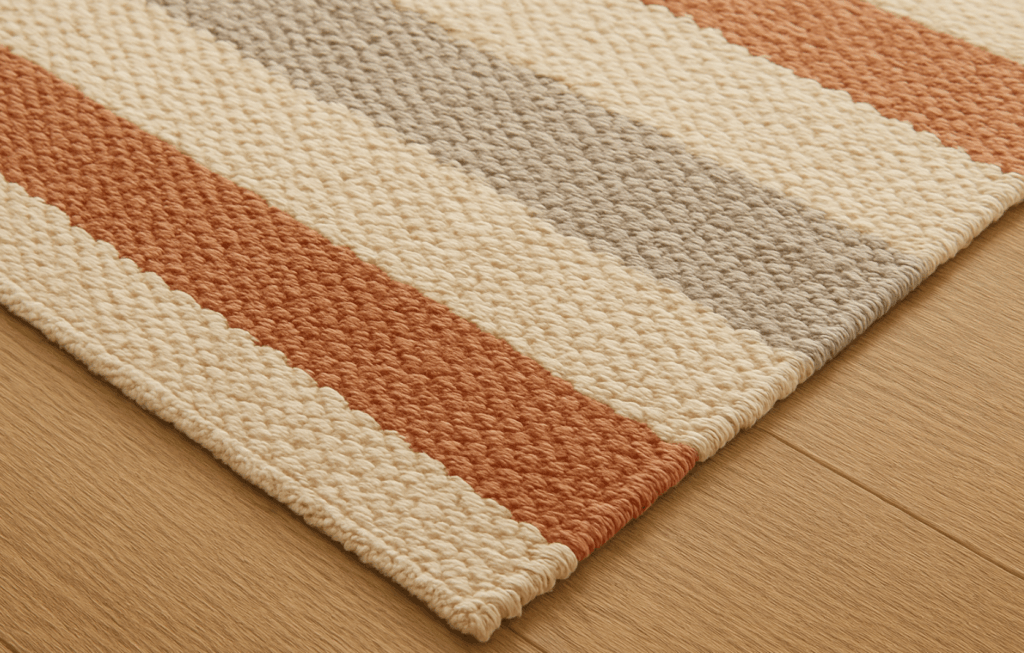
平織りラグの特徴
- 杭工事なし:タフテッドラグやノットラグと違い、平織りには毛足がないため、床と同じ高さになるようなスマートな形をしています。
- 軽量でリバーシブル:薄いので移動、掃除、収納が簡単です。多くの平織りラグはリバーシブルで、使いやすさとデザインの自由度が広がります。
- 素材の多様性:ウール、コットン、ジュート、合成繊維から作られるのが一般的で、それぞれの素材が風合い、耐久性、お手入れの必要性などの点で独自の利点を備えている。
- デザインの多様性:平織りのラグは、伝統的なキリムやドゥリーのデザインから現代的な幾何学モチーフまで、複雑な模様と鮮やかな色彩が特徴です。
平織りラグの利点
- 耐久性:平織りラグはしっかりと織られているため磨耗に強く、廊下やキッチン、リビングルームなど人の出入りの多い場所に最適です。
- 簡単さ メンテナンス:表面が平らなため、汚れやゴミがこびりつきにくく、ハイパイルラグに比べて掃除が簡単です。定期的な掃除機がけと、すみやかなスポット清掃で十分です。
- 手頃な価格:一般的に、平織りのラグはパイル地のものよりもお求めやすく、スタイルに妥協することなく費用対効果の高いソリューションを提供します。
- レイヤリングの可能性:スリムな形なので、他のラグやカーペットの上に重ねるのに最適で、部屋のインテリアに深みと質感を加えます。
2.4 編みラグ
編み込みラグは、その素朴な魅力、耐久性、多用途性で知られる古典的で不朽の床敷物です。初期のアメリカの家庭で生まれたこのラグは、伝統的に布の端切れから作られ、暖かさと快適さを提供してきました。今日、編み込みラグは、伝統的な職人技とモダンな素材やデザインを融合させた、人気のある選択肢であり続けています。
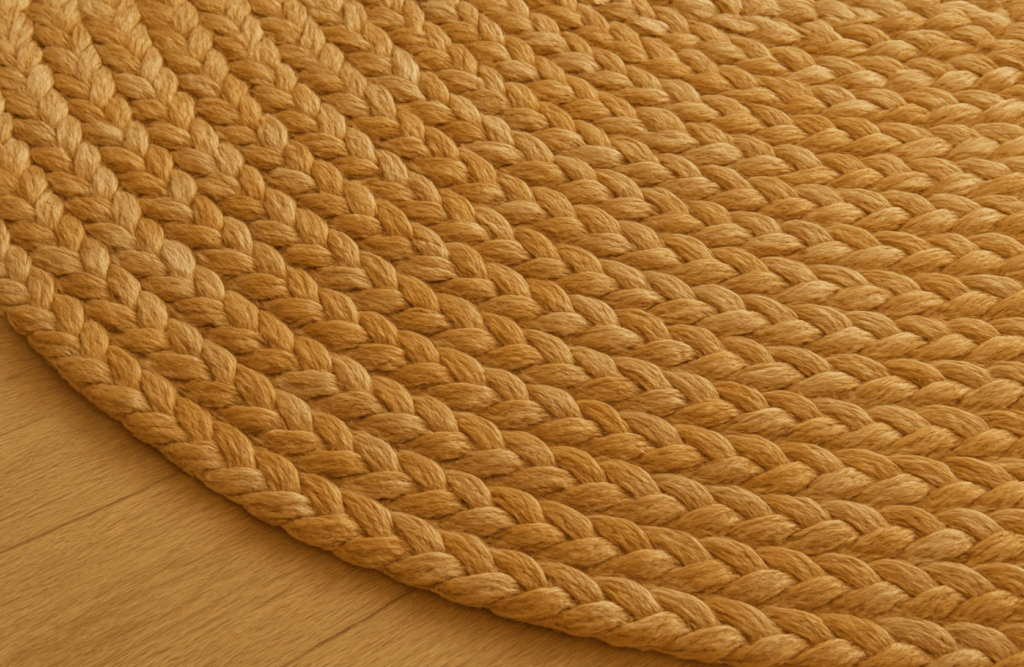
編み込みラグの利点
- 耐久性:編み込み構造は、特にウールや合成繊維で作られた場合に、強度と耐久性をもたらす。
- 可逆性:多くの編み込みラグはリバーシブルで、長期間使用でき、摩耗も防ぎます。
- 汎用性:さまざまな素材、色、形の編み込みラグは、素朴なものからモダンなものまで、さまざまなインテリアスタイルにマッチします。
- 環境に優しいオプション:ジュートやリサイクル素材などの天然繊維の編み込みラグは、環境意識の高い消費者に持続可能な選択肢を提供します。
構造と技術
三つ編みラグは、3本以上の布や糸を三つ編みにし、それを巻いて縫い合わせることで作られます。編み込みにはいくつかの方法があります:
- フラット・ブレイド:最も一般的な技法で、平らな三つ編みを並べて縫い合わせる。
- チューブラーブレイド:チューブ状のブレードを作り、それを平らにして縫う。
- ラウンド・ブレイド:ロープのようなブレードを作り出し、より質感のある外観を提供する。
編み込み技法の選択は、ラグの質感、厚み、全体的な美しさに影響します。
2.5 フック付きラグ
フックド・ラグはテキスタイル・アートの一種で、ループ状のテクスチャー、鮮やかな模様、北米の民俗的伝統に深く根ざしたものなどで知られる。19世紀に生まれたこの技法は、質素な素材を機能的で装飾的な床敷物に変え、機知と創造性を反映させた。
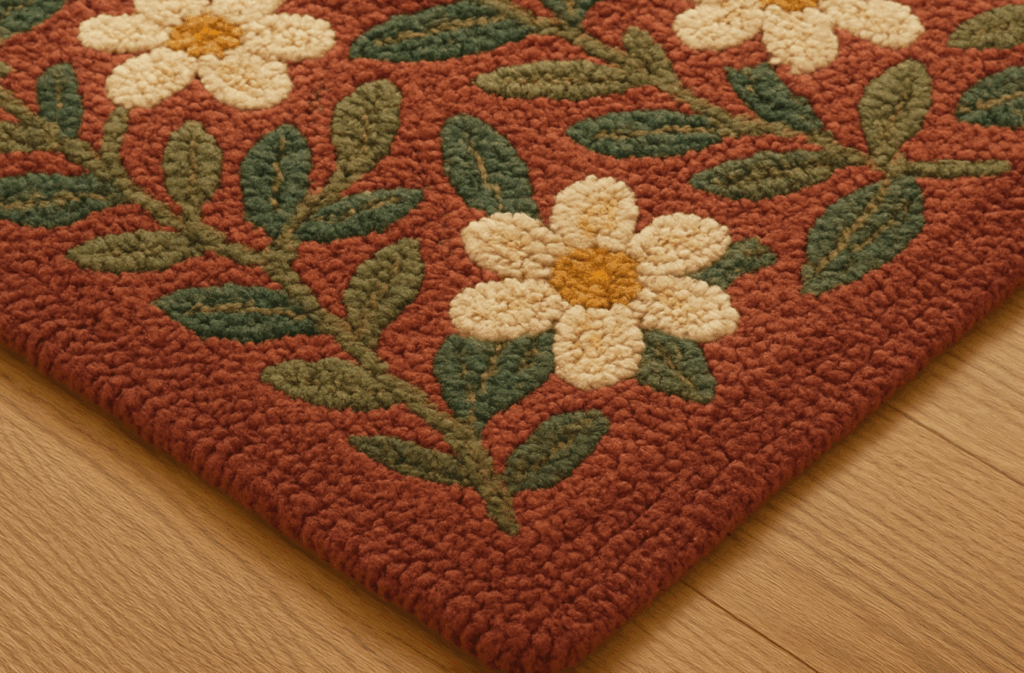
フック付きラグの利点
- 質感の魅力:ループ状の構造は触覚的な次元を加え、空間の感覚的な体験を高める。
- 芸術的表現:フックド・ラグはしばしば、物語や文化表現、個人の創造性を表現するキャンバスの役割を果たす。
- 耐久性:フック式ラグは適切にメンテナンスすれば、定期的な使用に耐え、その美しさを長く保つことができます。
- 環境に優しいオプション:多くのフック付きラグはリサイクル素材や天然素材から作られており、環境意識の高い消費者にアピールしている。
職人技とテクニック
フック・ラグの作り方は、麻布やリネンなどの丈夫な裏地に、かぎ針のようなフックを使って糸や布のループを引っ張ります。この方法によって、パイルの表面がループ状になり、独特の質感と視覚的な奥行きが生まれます。ループをカットしてふっくらとした表面を作るタフテッド・ラグとは異なり、フック・ラグはループを保持し、独特の外観と耐久性に貢献します。
フックド・ラグの中にもバリエーションがある:
- 手織りラグ:すべて手作業で作られるラグには職人の技が光り、複雑で個性的なデザインが多い。
- 機械織りラグ:機械化された工程で生産されるこれらのラグは、同じような美しさをより手に入れやすい価格帯で提供しています。
2.6 プリントラグ
プリントラグ ラグ・デザインへの現代的なアプローチであり、鮮やかな柄と高度なプリント技術による手頃な価格が魅力です。伝統的な織り方に伴う高いコストをかけずに、スタイリッシュな床材をお求めのご家庭に最適です。
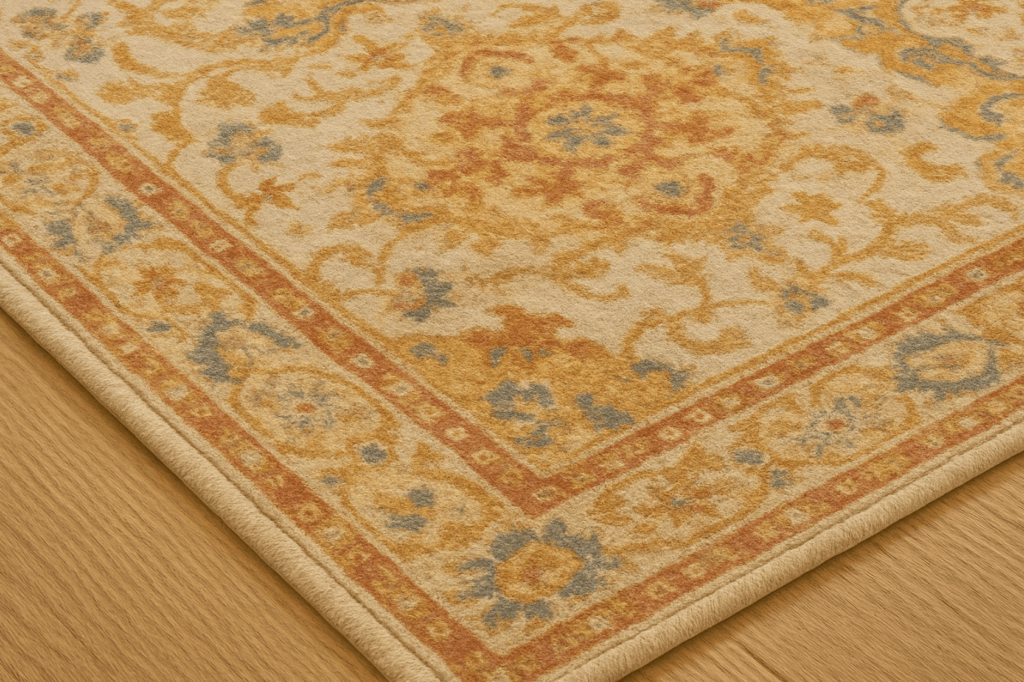
プリント・ラグの利点
- 手頃な価格:プリント絨毯は一般的に、手織りや手織りのタフテッド絨毯よりも費用対効果が高く、より多くの人が利用しやすい。
- デザインの柔軟性:色や柄のバリエーションが豊富で、流行にすばやく対応できる。
- 軽量で扱いやすい:移動、掃除、収納が簡単な構造。
- 低い メンテナンス:プリントラグは表面が平らなため、掃除が簡単で、定期的に掃除機をかけたり、時々スポット清掃をする必要があります。
構造と技術
プリント絨毯は、さまざまなプリント技法を使って、下地の生地に直接デザインを施して作られます。主な技法は以下の通りです:
- デジタル印刷:インクジェット技術を駆使し、高解像度で細部まで鮮明な画像を再現。
- スクリーン印刷:メッシュスクリーンを使ってインクを押し出し、パターンを作る。
- 昇華:熱を利用して染料を生地に転写し、鮮やかで耐久性のあるプリントを実現する。
これらの方法によって、大量生産でも正確で一貫性のある設計が可能になる。
3.スタイルまたは原産地別のラグ
ラグは機能性だけでなく、美的表現も重要です。世界的にインスピレーションを得た、スタイリスティックで象徴的なオプションを見てみましょう。
3.1 ペルシャ絨毯
現代のイランで生まれたペルシャ絨毯は、その複雑なデザイン、卓越した職人技、豊かな文化遺産で有名です。この手織りの織物は2,500年以上も前から作られており、現在でも行われている最も古い芸術のひとつです。
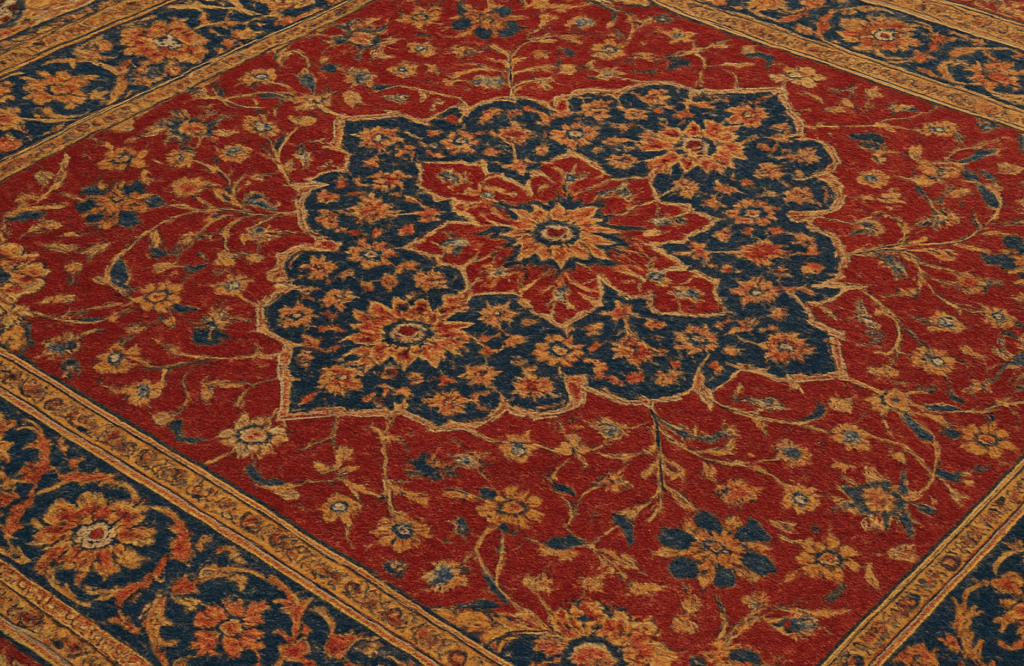
歴史的意義
ペルシャ絨毯織りの伝統は古代にさかのぼり、最も古いものは実用的かつ象徴的な目的で使われていた。何世紀にもわたり、ペルシャ絨毯は富と地位の象徴となり、しばしば王宮や外交の贈り物として使われました。その複雑なデザインと鮮やかな色彩は西洋世界を魅了し、テキスタイルやインテリアデザインのトレンドに影響を与えた。
素材と職人技
ペルシャ絨毯は通常、高品質のウール、シルク、またはその両方を組み合わせて作られます。ウールは丈夫で柔らかく、シルクは高級な光沢があり、より複雑なデザインが可能です。土台は通常コットンで、強度と安定性をもたらします。職人は非対称のペルシア結びなど独特の結び方を用い、複雑なデザインと耐久性を実現している。
デザインと象徴
それぞれのペルシャ絨毯は、そのモチーフ、色彩、原産地の文化的な影響を通して物語を伝えます。一般的なモチーフには、美と自然を表す花柄、調和とバランスを象徴する幾何学模様、統一と永遠を意味するメダリオンなどがあります。色彩は天然染料に由来し、鮮やかな外観がその魅力を高めています。
3.2 オリエンタルラグ
オリエンタル・ラグは、アジア、中東、北アフリカを含む「ラグ・ベルト」と呼ばれる地域を原産地とする手織り織物の幅広いカテゴリーです。これらのラグは、その複雑なデザイン、豊かな色彩、文化的意義で有名です。
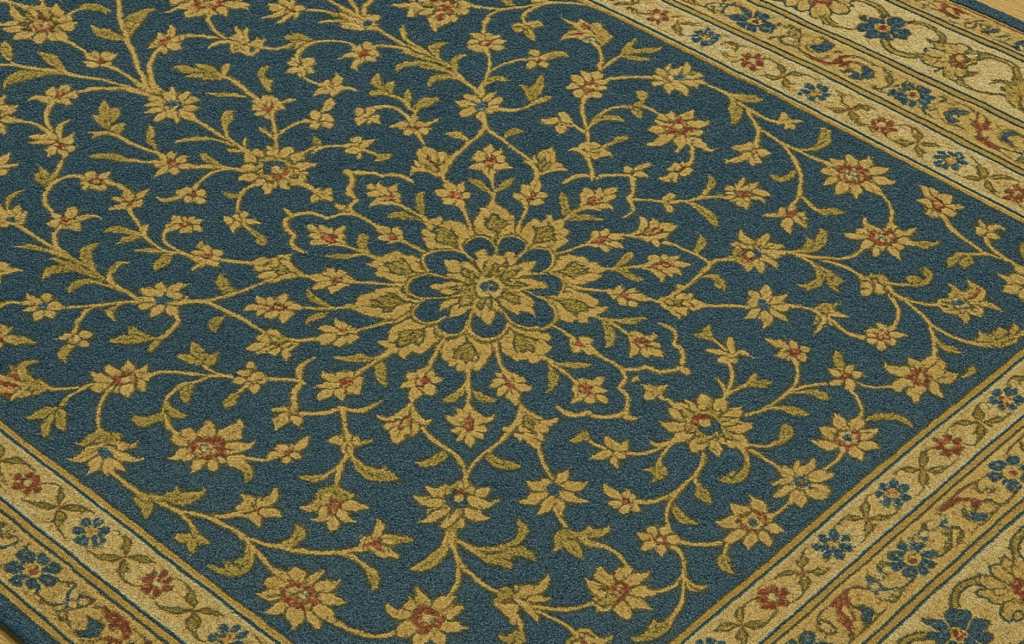
歴史的背景
東洋の絨毯織りの伝統は数千年前にさかのぼり、初期のものは古代ペルシャ(現在のイラン)で発見されている。この工芸品はシルクロードのような交易路に沿って広がり、さまざまな文化に影響を与え、また影響を受けました。時が経つにつれ、地域ごとに異なるスタイルが生まれ、それぞれが地域独自の芸術的感性や文化的物語を反映するようになりました。
主な特徴
- 材料:オリエンタルラグは通常、ウール、シルク、コットンなどの天然繊維から作られています。ウールは耐久性と柔らかさ、シルクは光沢と繊細さ、コットンは丈夫な土台として珍重されています。
- 織りのテクニック:手織りまたは平織りで、代々受け継がれてきた技術が使われています。結び目の密度や織り方は地域によって異なり、ラグの風合いや耐久性に影響します。
- デザインとモチーフ:オリエンタルラグには、幾何学的な形、花のモチーフ、象徴的な要素など、さまざまなパターンがあります。色彩は天然染料に由来し、鮮やかでありながら調和のとれた色調を生み出しています。
3.3 キリムとドゥルリーラグ
キリムとドゥリーのラグは、その複雑なデザイン、文化的意義、多用途性で有名な平織り織物です。織り方は似ていますが、それぞれの起源、モチーフ、用途が異なり、それぞれの文化の豊かなタペストリーを反映しています。
キリムラグ

キリム絨毯には何世紀にもわたる豊かな歴史と地域があります。平らで毛足がないのが特徴のキリム絨毯の原産地は、現在のイラン、トルコ(アナトリアとトラキア)、バルカン半島、テュルク諸国を含む旧ペルシャ帝国です。キリムの起源は紀元前1000年頃まで遡り、最古のものはエジプトのフォスタットで発見され、古代の文化的重要性を示している。
Dhurrie ラグ
ドゥーリ絨毯はインドやパキスタンの伝統的な手織り絨毯、または薄手のフラットカーペットで、家庭用家具として使われる。最もポピュラーな柄のひとつである多色のストライプなど、原産地からインスパイアされたユニークなデザインが特徴です。
3.4 シャギーラグ
深い毛足とふっくらとした質感で有名なシャギーラグは、何十年もの間、インテリアデザインにおける快適さとスタイルの象徴であり続けてきました。そのユニークな外観と手触りから、さまざまな空間に温かみと個性を加える人気商品となっています。
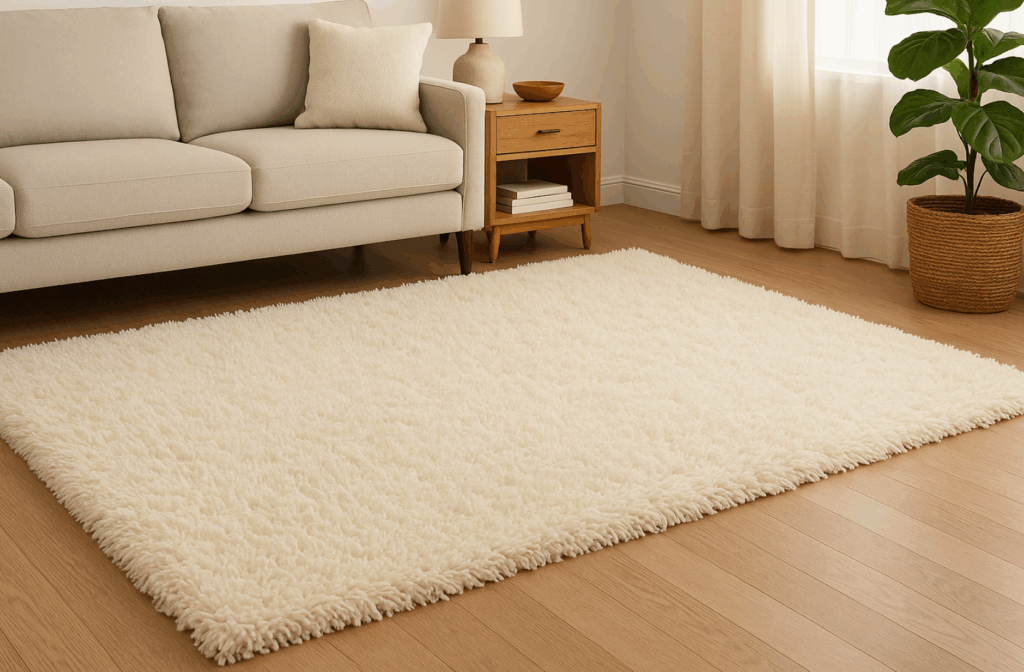
歴史的背景
シャギーラグの起源は古代まで遡ることができ、ギリシャの "フロカティ "ラグのような初期の例は、伝統的に羊の毛から作られ、5世紀にはすでにギリシャの田舎の家で使われていました。これらのラグは優れた断熱性を発揮すると同時に、インテリアに手触りの良さを加えていました。1960年代から1970年代にかけて、シャギーラグはアメリカや西ヨーロッパで、ポップカルチャーを席巻していたボヘミアンスタイルの一部として絶大な人気を博しました。その深い毛足とファンキーな美しさは、ミッドセンチュリーモダンのミニマリズムのクリーンなラインに対する大胆な自己表現と居心地の良い反抗の時代を定義しました。
デザイン・バリエーション
シャギーラグにはさまざまなスタイルとデザインがあり、さまざまな美的嗜好に対応しています:
- フロカティ:ギリシャ原産のこのラグは100%ウール製で、ふわふわの厚いパイルで知られています。伝統的には白かクリーム色ですが、様々な色に染めることができます。
- リヤ:スカンジナビアのラグで、毛足が密で長く、複雑な模様と鮮やかな色彩が特徴です。歴史的に寝具や装飾品として使われてきました。
- コンテンポラリー・シャギー:モダンなシャギーラグは、幾何学的なデザイン、大胆な色使い、ミックスされた質感など、さまざまな素材やパターンを取り入れており、さまざまなインテリアスタイルに対応します。
3.5 ディストレス・ラグ
ディストレスト加工を施したラグは、空間に個性と温もり、そして歴史を感じさせることから、インテリアデザインのトレンドとして注目されています。このようなラグは、本物のエイジング加工を施したものであれ、使い古したような芸術的な加工を施したものであれ、ヴィンテージの魅力とコンテンポラリースタイルのギャップを埋めるユニークな美的感覚を提供します。
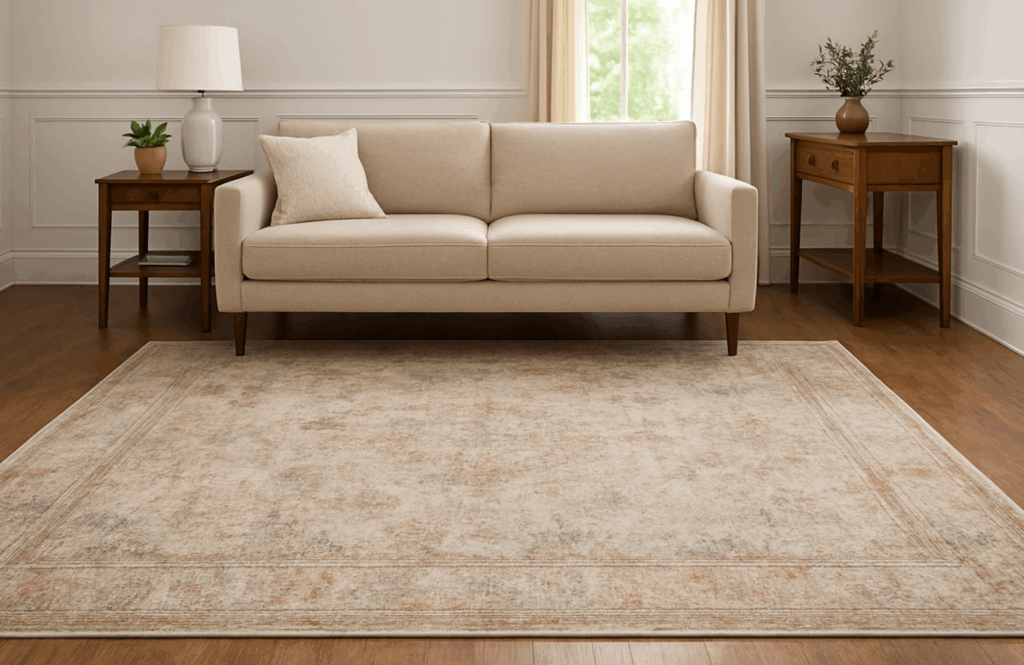
ディストレス・ラグとは?
ディストレスド・ラグは、色あせた色、擦り切れた模様、柔らかくなった質感が特徴で、意図的に経年変化を表現した床敷物です。この効果は、時間の経過による自然なエイジングや、摩耗をシミュレートする現代的な技術によって得ることができます:
- シャーリング:絨毯の毛足を整えて凹凸を作り、自然な摩耗を模倣すること。
- 洗濯:特定の洗いをかけることで、色落ちし、繊維が柔らかくなる。
- 研磨:意図的なカラーバリエーションを導入し、経年変化をエミュレート。
こうした手法の結果、生活感が漂い、インテリア空間に深みと物語性を与えるラグが生まれる。
3.6 コンテンポラリーラグ
コンテンポラリーラグは現在のデザイントレンドを反映し、モダンなインテリアに合う多様性と幅広いスタイルを提供します。特定の歴史的パターンに固執する伝統的なラグとは異なり、コンテンポラリーラグは革新的で、抽象的なデザイン、大胆な色使い、ユニークなテクスチャーが特徴です。
特徴の定義
- デザインの美学:コンテンポラリーラグは、抽象的なパターンや幾何学的な形、非対称のデザインが特徴です。これらの要素はモダンでダイナミックな印象を与え、部屋のフォーカルポイントとして機能します。
- カラーパレット:伝統的なラグは決まった色を使いますが、コンテンポラリーラグはそのような制約がありません。ニュートラルな色調、鮮やかな色調、あるいはその両方の組み合わせなど、求める効果によって使い分けることができます。
- 材料:一般的な素材には、ウール、シルク、コットン、ナイロンやポリエステルなどの合成繊維があります。素材の選択はラグの質感、耐久性、メンテナンスの必要性に影響します。
- テクスチャーとパイル:コンテンポラリーなラグは、平織りからシャギーまで、パイルの高さやテクスチャーがさまざまで、デザインに深みと面白みを加えています。
3.7 アーティスティック・ラグ
アーティスティック・ラグは機能的な用途を超え、文化的な物語や個人的な表現、革新的なデザインを映し出すキャンバスの役割を果たします。これらのラグは単なる床材ではなく、インテリア空間に深みと個性、そしてストーリー性をもたらす織物作品なのです。
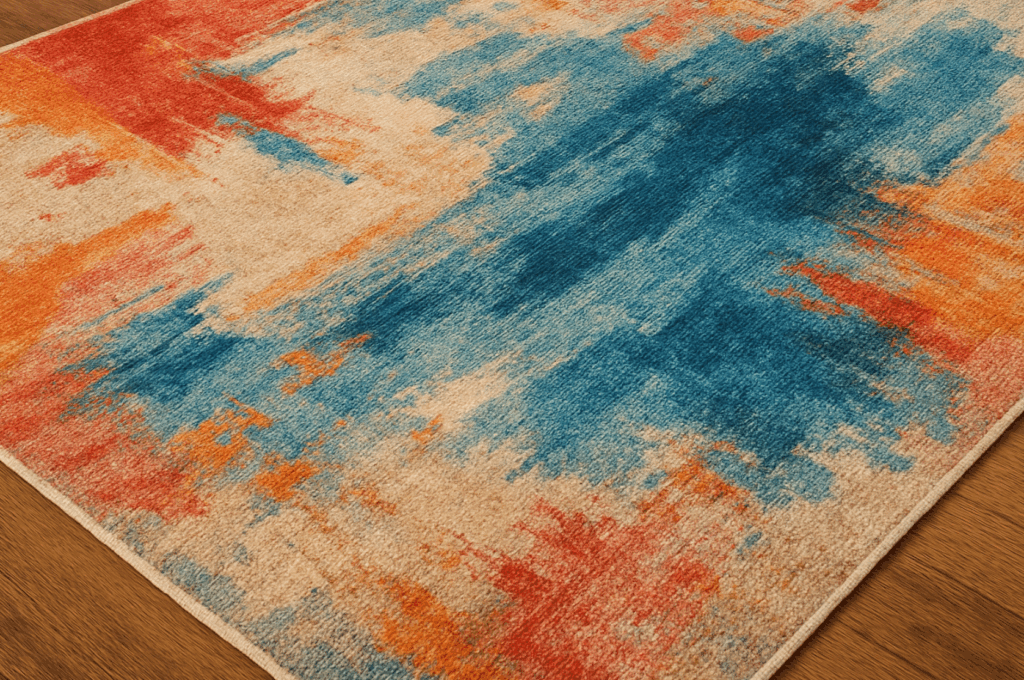
芸術的ラグの定義
アーティスティックラグは、さまざまな芸術運動や文化的モチーフ、個人的表現からインスピレーションを得たユニークなデザインが特徴です。既成のパターンに従う伝統的なラグとは異なり、アーティスティック・ラグは既成概念を打ち破り、抽象的な形、鮮やかな色、型にはまらない素材を取り入れて、視覚的に印象的な作品を生み出します。
4.特殊ラグ
ラグの中には、美観を超えた実用性や大胆な独自性を提供するものもあります。
4.1 ハイドラグ
ハイドラグ、特に牛革で作られたラグは、現代のインテリアデザインにおいて特徴的な要素となっています。そのユニークな柄、耐久性、自然な風合いは、素朴な山小屋からモダンなロフトまで、さまざまな空間を多彩に彩ります。
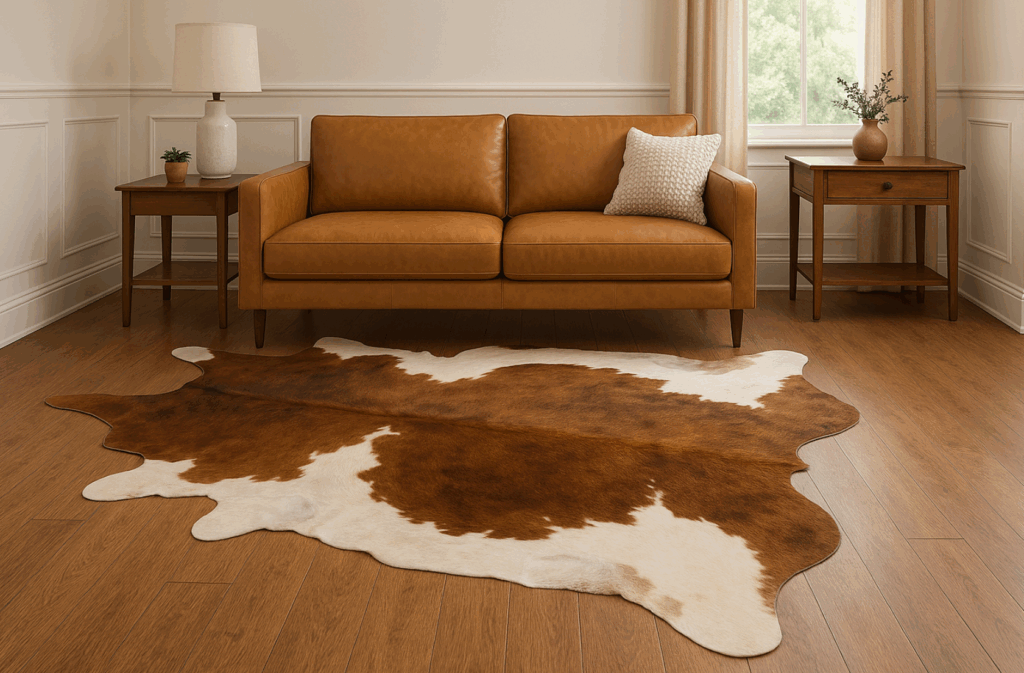
起源と職人技
牛革ラグは食肉産業の副産物である牛の皮から作られます。自然の美しさを保ち、長持ちさせるため、皮は細心の注意を払ってなめされます。主ななめし方法は2種類あります:
- ベジタブル・タンニング:植物由来の天然タンニンを使用し、豊かでアースカラーの環境に優しいラグを実現。
- クロムなめし:クロム塩を使用し、より柔らかくしなやかな皮革を生産する。
牛革ラグは、無地のものから複雑な模様のものまで、動物の自然な模様が表現されており、それぞれがユニークです。この個性が、同じラグが2つとないことを保証し、どんな部屋にもパーソナライズされたタッチを加えます。
4.2 屋外用ラグ
屋外用ラグは、屋外空間の美観と快適性を高めると同時に、風雨に耐えるよう特別にデザインされています。パティオやデッキ、バルコニーなどの屋外スペースをより心地よく、まとまりのある空間にします。
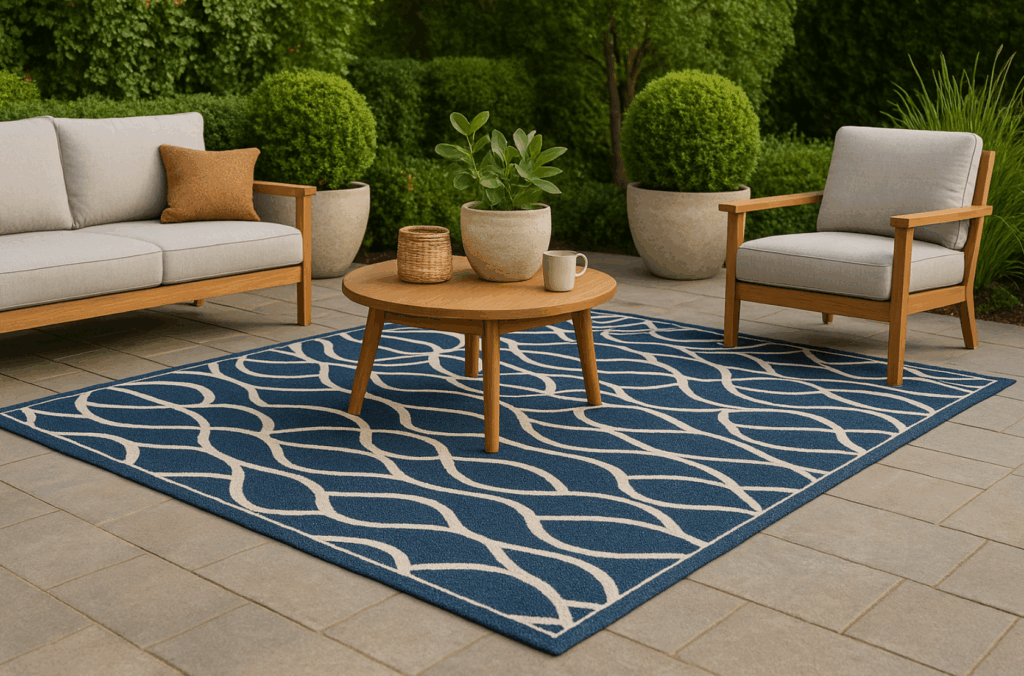
素材と構造
屋外用ラグの耐久性と性能は、使用されている素材に大きく左右されます:
- ポリプロピレン:湿気やカビ、紫外線に強いことで知られる人気の合成繊維。軽くてお手入れが簡単で、時間が経っても色の鮮やかさを保ちます。
- ポリエステル:ソフトな風合いで、色あせや汚れに強い。ただし、人の出入りが多い場所では、ポリプロピレンほどの耐久性はないかもしれません。
- ナイロン:丈夫で弾力性があることで知られるナイロン製ラグは、人の出入りが激しくても大丈夫ですが、紫外線によるダメージを受けやすくなります。
- 天然繊維(ジュート、バンブー、サイザル麻など):素朴で有機的な外観。環境に優しい反面、これらの素材は湿気に弱く、湿気の多い環境には適さない場合があります。
ほとんどの屋外用ラグは平織りの技法で作られており、パイルの少ない表面は乾きが早く、汚れがたまりにくくなっています。
5.形状別ラグ
ラグの形状は、空間の美観と機能性を決定づける極めて重要な役割を果たします。ラグの形が適切であれば、単なる装飾にとどまらず、家具の配置を調和させたり、オープンな間取りの中でエリアを区切ったり、視覚的なバランスを整えたりすることができます。さまざまなラグの形とその理想的な用途を理解することは、住宅所有者やデザイナーが十分な情報を得た上で選択するための指針となります。
5.1 長方形のラグ
長方形のラグは最も一般的で汎用性の高い形状で、さまざまな空間にシームレスにフィットします。
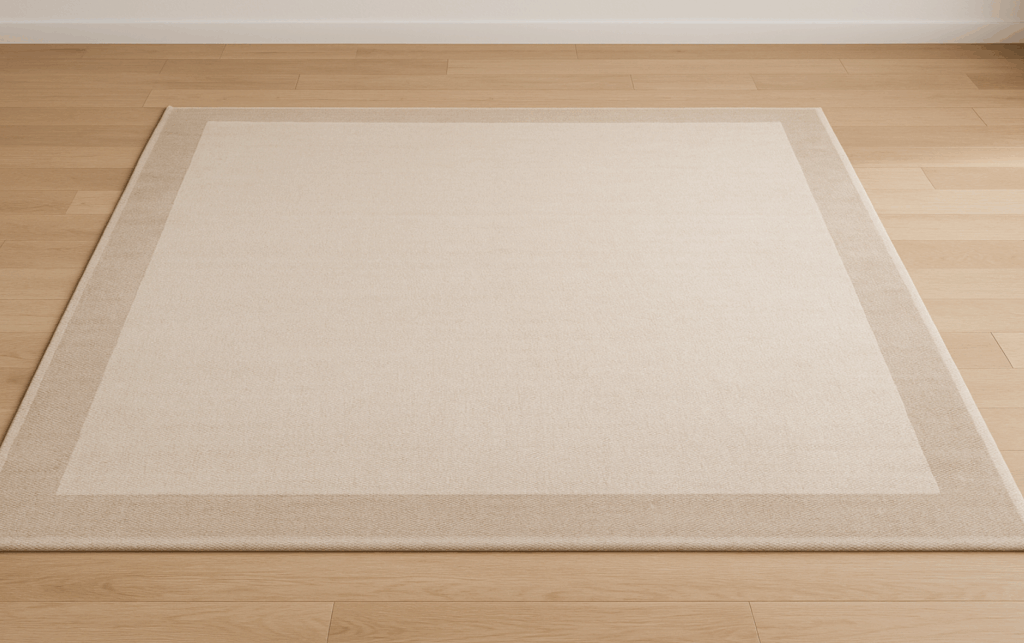
理想的な用途:
- リビングルーム:コーヒーテーブルやシーティングの下に置いて、空間のアクセントに。
- ダイニングルーム:ダイニングテーブルの下に敷くことで、椅子を引き出してもラグの上に置いたままにできる。
- ベッドルーム:ベッドの下に敷き、側面と足元まで伸ばして寝心地を良くする。
デザインのヒント:視覚的なバランスを保つため、家具や部屋のサイズに合ったラグを選びましょう。
5.2 正方形のラグ
正方形のラグはシンメトリーな魅力があり、正方形の部屋やバランスが必要な場所に適しています。
理想的な用途:
- 小さなリビングエリア:正方形のコーヒーテーブルの下、または座席の配置。
- ベッドルーム:四角いベッドの下や読書コーナーに。
- 玄関:シンメトリーなホワイエ空間を演出する。
デザインのヒント:ラグを部屋のジオメトリーに合わせると、まとまりが出ます。
5.3 ラウンドラグ
丸いラグは柔らかさをもたらし、角ばった家具や部屋のレイアウトの単調さを打ち破ることができる。
理想的な用途:
- ダイニングエリア:丸いダイニングテーブルの下は、テーブルの形に合わせて。
- ベッドルーム:丸いベッドの下や円形のシーティングエリアに置く。
- 玄関:歓迎のフォーカルポイントを作る
デザインのヒント:丸いラグは、シャープな建築の特徴を和らげたり、円形のデザイン要素を際立たせるために使います。
5.4 楕円形のラグ
楕円形のラグは、長方形の細長さと円形の柔らかさを併せ持ち、ユニークな美しさを提供します。
理想的な用途:
- ダイニングルーム:楕円形のダイニングテーブルの下で、形状を統一。
- 廊下:廊下に沿って視線を誘導する。
- リビングルーム:ソファの前やコーヒーテーブルの下に置いて、優しい雰囲気を演出。
デザインのヒント:楕円形のラグは、長方形の部屋の堅苦しさを和らげ、優雅な流れを加えます。
5.5 ランナーラグ
ランナーラグは細長く、狭いスペースにフィットし、動きを誘導するようにデザインされている。
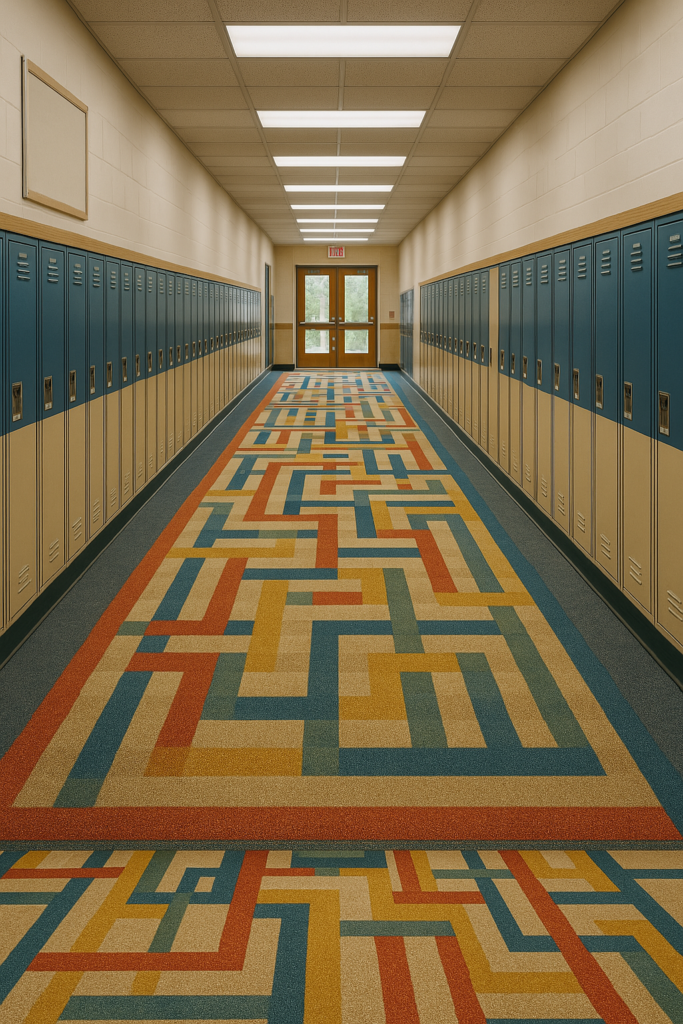
理想的な用途:
- 廊下:暖かみを加え、ノイズを減らす。
- キッチン:ギャレーキッチンやシンクの前に置くと快適。
- 階段:トラクションと美しさを提供する。
デザインのヒント:ランナーが中央に来るようにし、左右対称になるように均等なスペースを残す。
5.6 半月(半円)ラグ
半月形のラグは三日月形のラグとも呼ばれ、片面が平らでもう片面がカーブしており、独特の表情を持っています。
理想的な用途:
- 玄関:ドアのすぐ内側に置かれ、ゲストを迎える。
- バスルーム:バスタブやシンクの前。
- 暖炉:囲炉裏のアクセントに。
デザインのヒント:平らなエッジを壁や家具に合わせると、まとまりのある外観になります。
5.7 八角形のラグ
八角形のラグは8つの面を持ち、伝統的な形に代わる幾何学的な形を提供します。
理想的な用途:
- ダイニングルーム:八角形または円形のテーブルの下。
- フォイヤーズ:印象的な第一印象を与えること。
- スタディルーム:デスクやシーティングエリアの下のセンターピースとして。
デザインのヒント:八角形のラグは、視覚的な面白さをもたらし、従来のパターンを打ち破るために使う。
5.8 動物の皮と不規則な形の敷物
これらのラグは有機的で自由な形をしており、動物の皮革や抽象的なデザインを模したものが多い。
理想的な用途:
- リビングルーム:コーヒーテーブルの下のステートメント・ピースとして。
- ベッドルーム:ベッドの横に置いて高級感を演出。
- 事業所:個性と独自性を加える。
デザインのヒント:ミニマルな家具と組み合わせて、ラグを際立たせる。
6.スペースに合ったラグを選ぶ
パーフェクトなラグを選ぶには、単に好みのデザインを選ぶだけではありません。ここでは、十分な情報を得た上で決定するための包括的なガイドをご紹介します:
部屋の機能を決める
部屋の目的を理解することは非常に重要だ:
- リビングルーム:人の出入りが多くても大丈夫な丈夫なラグを選びましょう。
- ベッドルーム:ふかふかで心地よいラグを選ぶと、足元が心地よくなります。
- ダイニングルーム:掃除がしやすく、食べこぼしにも対応できるラグを選びましょう。
- 廊下/玄関:つまずきを防ぐため、丈夫で毛足の少ないラグを探す。
適切なサイズを選ぶ
ラグはサイズが重要です:
- リビングルーム:ラグは主要な家具の下、または少なくとも前脚の下に収まる大きさであることを確認してください。
- ダイニングルーム:椅子を置くために、ラグはテーブルから24インチ以上はみ出すこと。
- ベッドルーム:クイーンベッドの場合、ラグのサイズは8×10フィートのものが理想的で、キングベッドの場合は9×12フィートのものが効果的です。
適切な素材を選ぶ
素材はラグの見た目と機能性の両方に影響します:
- ウール:丈夫で柔らかく、人通りの多い場所に最適。
- コットン:軽量で掃除がしやすく、カジュアルな空間に適しています。
- ジュート/サイザル麻:風合いを増す天然繊維で、人通りの少ない場所に最適。
- 合成繊維(ナイロン、ポリプロピレンなど):汚れに強く、手頃な価格で、家族やペットに最適。
色と柄を考える
ラグの色や柄は、既存のインテリアと調和するようにします:
- ニュートラル・カラー:鎮静効果があり、用途が広い。
- ボールド・パターン:視覚的な面白さを加え、フォーカルポイントとなる。
- ダークカラー:汚れを隠し、人通りの多い場所での使用に適している。
メンテナンスについて考える
掃除にどれだけの労力を費やせるか考えてみよう:
- ローパイル:手入れが簡単。
- ハイパイル/シャギーラグ:メンテナンスは必要だが、高級感がある。
- 洗濯機で洗えるラグ:子供やペットのいる家庭に最適。
予算
ラグにはさまざまな価格帯がある:
- 品質への投資:よくできたラグは何年も使えます。
- 手頃なオプション:スタイリッシュで丈夫なラグが低価格でたくさんあります。
購入前のテスト
可能であれば、実際にラグを見るか、サンプルを注文してください:
- テクスチャーのチェック:足元が快適であること。
- 色の評価:さまざまな照明条件下では、色が異なって見えることがあります。
これらの要素を考慮することで、空間の美しさを引き立てるだけでなく、実用的なニーズにも応えられるラグを選ぶことができます。
7.結論
結論として、完璧なラグを選ぶには、単にデザインを選ぶだけでなく、素材、織り方、形状の相互作用を理解し、それらがインテリア空間をどのように引き立てるかを理解することが重要です。ペルシャ絨毯の時代を超越したエレガンスから合成繊維の現代的な魅力まで、それぞれのタイプは異なるニーズや美的感覚に合わせたユニークな利点を提供します。部屋の機能、人の出入り、個人のスタイルなどを考慮することで、快適さと見た目の美しさの両方を向上させることができます。
8.よくあるご質問
Q1: 一番掃除しやすいラグは何ですか?
A: 平織りまたは合成繊維のラグ。汚れに強く、洗濯できることが多い。
Q2: ウールラグはアレルギーに良いのですか?
A: はい!ウールはもともとダニやアレルゲンを寄せ付けないが、定期的に掃除機をかけること。
Q3: 屋内用ラグは屋外でも使えますか?
A: 室内用ラグは紫外線や湿気に弱く、すぐに劣化してしまいます。
Q4: ダイニングテーブルの下に敷くラグのサイズは?
A: 椅子が置けるように、ラグはテーブルの四方から少なくとも24インチははみ出させること。
Q5: カーペットはどのくらいの頻度で取り替えるべきですか?
A: 高品質のラグは何十年も使えます。低価格のものは、摩耗に応じて5~10年ごとに交換してください。

